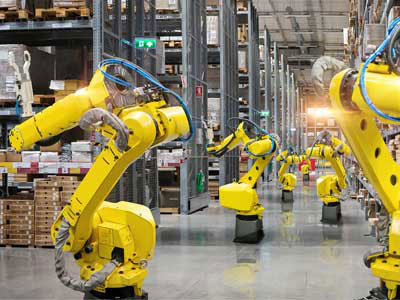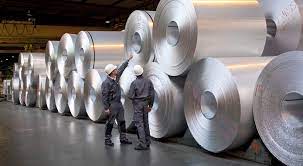Latest Technological Innovations Revolutionizing the Industrial Robot Industry

Strong 8k brings an ultra-HD IPTV experience to your living room and your pocket.
Introduction:
The industrial robot industry has seen significant advancements over the last decade, transforming manufacturing, logistics, healthcare, and many other sectors. As technology progresses, the role of robots in industrial operations continues to evolve, enabling businesses to streamline processes, improve safety, and enhance productivity. Among the most notable technological innovations in the industrial robotics field are Robotics as a Service (RaaS), collaborative robots, advancements in artificial intelligence (AI), and breakthroughs in connectivity. These innovations are making industrial robots more accessible, efficient, and capable of handling increasingly complex tasks.
In this article, we explore how the latest technological advancements are reshaping the industrial robot industry, focusing specifically on the growing trend of Robotics as a Service (RaaS) and its impact on the accessibility and affordability of industrial automation.
Robotics as a Service (RaaS): Making Industrial Robotics More Accessible
Robotics as a Service (RaaS) is one of the most disruptive trends in the industrial robot industry. This innovative model enables businesses to access robotic solutions on a subscription or pay-per-use basis, allowing them to implement automation without the need for significant upfront investments. Rather than purchasing robots outright, companies can lease them, including both hardware and software, for a set period of time. This model provides a flexible and cost-effective way for businesses, particularly small and medium-sized enterprises (SMEs), to integrate robotics into their operations.
How Robotics as a Service Works
RaaS operates on a subscription-based or leasing model, where companies can lease robots and associated services, including maintenance, software updates, and customer support. Providers typically offer packages that cover everything a company needs to operate robots effectively, from the initial setup to ongoing upgrades. This approach eliminates the need for businesses to invest in expensive robotic equipment and infrastructure, lowering the barrier to entry for automation.
One of the most appealing features of RaaS is its scalability. Companies can easily scale up or down depending on their needs, allowing them to adjust the number of robots and the level of service according to changes in demand. This makes RaaS an attractive option for businesses that experience fluctuating production requirements or those that only need robots for specific tasks.
The Benefits of RaaS for Businesses
Cost-Effectiveness
The most significant advantage of RaaS is that it makes industrial robots more affordable for businesses. Purchasing industrial robots can involve a significant upfront investment, with the cost of a single robot often reaching tens of thousands of dollars. For many companies, especially smaller ones, this can be a financial barrier that prevents them from adopting automation.
With RaaS, businesses can avoid the large capital expenditures associated with purchasing robots. Instead, they can pay a monthly or annual fee, which typically includes all maintenance, software updates, and technical support. This pay-as-you-go model makes industrial automation more accessible to a broader range of businesses, allowing them to reap the benefits of robotics without the burden of high initial costs.
Reduced Maintenance and Operational Costs
RaaS providers typically include maintenance and repair services as part of the subscription package. This means businesses do not have to worry about the costs associated with maintaining robots, such as repairs, parts replacement, and servicing. The service provider is responsible for ensuring the robots remain in optimal working condition, which helps minimize unexpected downtime and reduces the operational costs associated with maintaining robots in-house.
Additionally, as robots are integrated with advanced technologies such as AI, machine learning, and remote monitoring, they can often self-diagnose issues and alert service teams to potential problems before they escalate. This predictive maintenance capability helps reduce the risk of downtime and improves the reliability of the robots, contributing to overall operational efficiency.
Flexibility and Scalability
Robotics as a Service offers businesses a high level of flexibility. Companies can choose from a range of robots and services based on their specific needs, and the flexibility to adjust their subscriptions as required is a key benefit. For example, during periods of high demand, businesses can lease additional robots to increase their capacity, and when demand decreases, they can scale down without incurring penalties.
The scalability of RaaS makes it an ideal solution for industries with fluctuating production needs, such as logistics, e-commerce, and manufacturing. Businesses that do not have the capital or the need to purchase robots outright can easily access cutting-edge robotic solutions and scale their operations as their business grows.
Access to Cutting-Edge Technology
As robotics technology advances rapidly, staying up to date with the latest developments can be challenging for businesses that rely on purchased robots. With RaaS, however, companies have access to the most advanced robots and software without the need for continuous capital investment. The service provider is responsible for ensuring that the robots and software remain current, with regular updates and upgrades included in the subscription package.
This access to the latest robotics technology helps businesses stay competitive in a rapidly evolving market, enabling them to take advantage of new features, capabilities, and performance improvements. Furthermore, RaaS providers often include AI-driven software that optimizes the performance of robots, ensuring that businesses get the most out of their robotic systems.
Collaborative Robots: Enhancing Human-Robot Interaction
Collaborative robots (cobots) are another breakthrough innovation that is transforming the industrial robot industry. Unlike traditional industrial robots, which operate in isolation and often require safety barriers to protect human workers, cobots are designed to work alongside humans in a shared workspace. These robots are equipped with sensors and safety features that enable them to detect and respond to human presence, making them safe to work with without the need for protective enclosures.
Cobots are highly flexible and can be easily integrated into existing production lines. They are often used for repetitive, physically demanding tasks such as assembly, material handling, and packaging. By performing these tasks, cobots allow human workers to focus on higher-level tasks that require problem-solving, creativity, and decision-making.
The integration of cobots into the workplace offers several benefits, including increased productivity, improved safety, and enhanced job satisfaction for human workers. Cobots can work continuously without the need for breaks, leading to higher throughput and reduced downtime. Additionally, because they are designed to be safe and easy to work with, cobots help minimize the risk of workplace injuries, contributing to a safer work environment.
Artificial Intelligence and Machine Learning: Making Robots Smarter
AI and Machine Learning are playing an increasingly important role in the evolution of industrial robots. These technologies enable robots to learn from experience, adapt to new environments, and improve their performance over time. By integrating AI and machine learning, robots can analyze data, make real-time decisions, and optimize their actions to improve efficiency and reduce errors.
For example, AI-powered robots can perform quality control tasks by analyzing visual data and detecting defects in products. Machine learning algorithms enable the robots to continuously improve their accuracy, becoming more effective at identifying issues and improving product quality. Similarly, AI-driven predictive maintenance allows robots to monitor their own performance and predict when maintenance is required, reducing the risk of unplanned downtime.
The integration of AI and machine learning also enhances the collaboration between humans and robots. Robots with AI capabilities can learn to understand and anticipate human actions, improving their ability to work alongside humans and assist with tasks. This integration of intelligence makes robots more autonomous and adaptable, helping them perform more complex tasks and increasing their utility across a wider range of industries.
IoT and 5G: Enabling Real-Time Communication
The Internet of Things (IoT) and 5G connectivity are playing a pivotal role in revolutionizing the industrial robot industry. IoT allows robots to be connected to the internet, enabling real-time data collection and analysis. This connectivity allows robots to monitor their own performance, share data with other machines, and communicate with operators for real-time decision-making.
The introduction of 5G technology further enhances the capabilities of IoT-connected robots. With faster data transfer speeds and lower latency, 5G enables robots to communicate with other machines and control systems in real-time, improving the efficiency and synchronization of production processes. This connectivity is particularly important in environments where robots need to work collaboratively with other machines, such as in automated warehouses or assembly lines.
The Future of Robotics as a Service
The RaaS model is expected to grow significantly in the coming years as more businesses recognize the advantages of flexible, subscription-based access to robotic systems. As the demand for automation continues to rise, RaaS will become an increasingly popular option for businesses looking to integrate robots into their operations. The model offers a cost-effective, scalable solution that makes industrial robotics more accessible, particularly for SMEs that may not have the financial resources to purchase robots outright.
Furthermore, as AI, machine learning, and IoT technologies continue to evolve, the capabilities of RaaS robots will become even more sophisticated. This will open up new opportunities for businesses to take advantage of advanced robotic solutions and drive innovation in industries ranging from manufacturing and logistics to healthcare and beyond.
Conclusion
Robotics as a Service (RaaS) is one of the most transformative trends in the industrial robot industry, making automation more accessible, flexible, and cost-effective for businesses of all sizes. By offering a subscription-based model that includes hardware, software, and support services, RaaS enables companies to access cutting-edge robotics technology without the need for significant upfront investment. This accessibility, combined with the flexibility to scale operations and access the latest advancements, is revolutionizing industries and driving the adoption of robotics across various sectors.
As RaaS continues to grow and evolve, it will play a central role in the future of industrial automation, enabling businesses to stay competitive, improve productivity, and optimize their operations. With the rise of cobots, AI, IoT, and 5G connectivity, the industrial robot industry is on the cusp of a new era, where advanced robots are not only more accessible but also more intelligent and capable than ever before.
Read the complete blog: https://www.nextmsc.com/blogs/industrial-robots-market-trends
Note: IndiBlogHub features both user-submitted and editorial content. We do not verify third-party contributions. Read our Disclaimer and Privacy Policyfor details.







